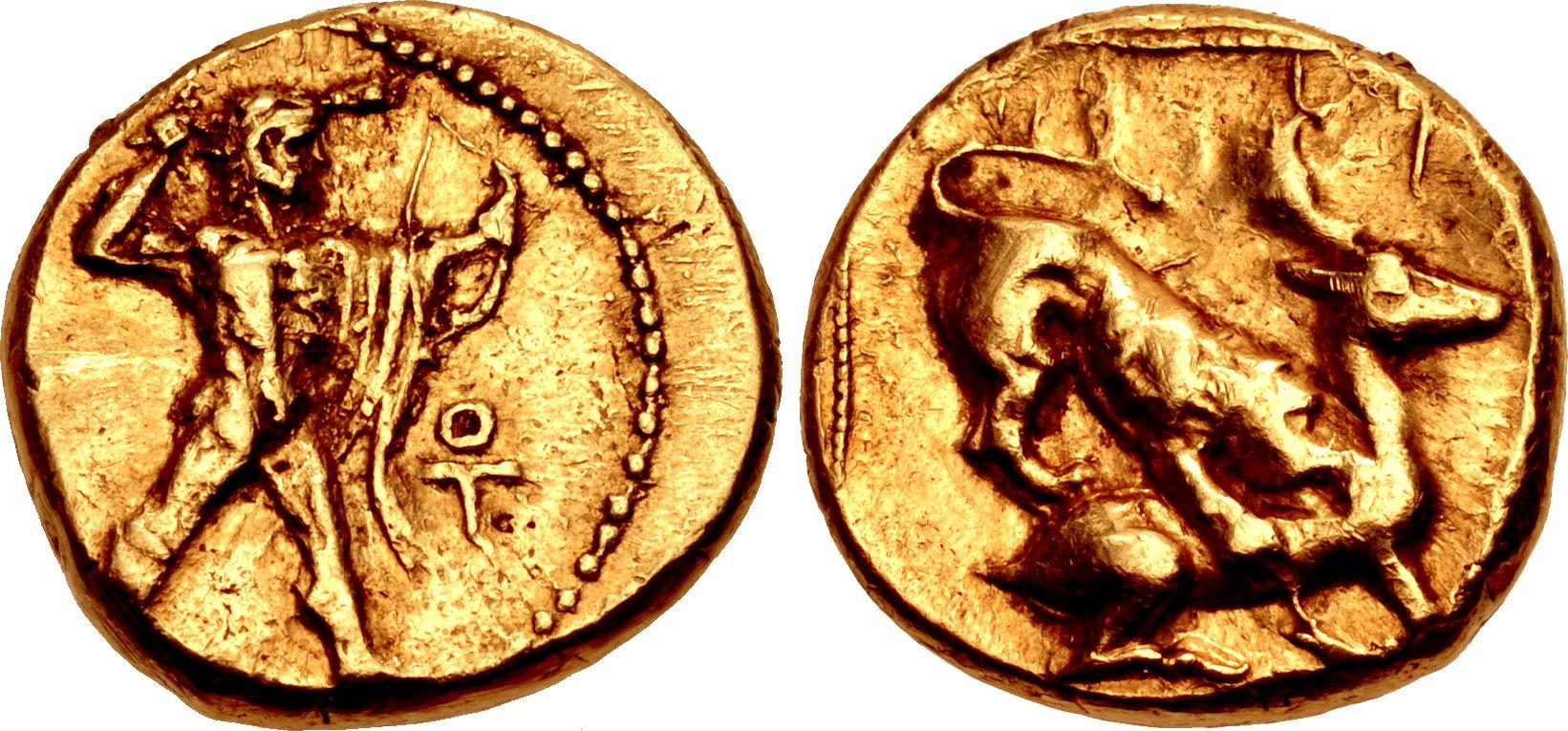S 1307 - Citium (Pumiathon), gold, hemistaters (362-312 BCE)
From SILVER
360 BCE - 359 BCE Gold 36,523 kg
Description
| ObverseInscription or printing placed on the obverse.: | Herakles to right, wearing the lion headdress, holding Nemean lion scalp, a bow and brandishing a club. In the field, a handled cross. Border of dots. |
| ReverseInscription or printing placed on the reverse.: | [L]MLK PMIA[TN] (in Aramaic = "of king Pumiathon" (Aramaic).Lion to right biting a lying deer. In the field, date in Phoenician. Border of dots. |
Mint and issuing power
| MintIdentifies the place of manufacture or issue of a numismatic object.: | Citium | Ancient regionAncient region.: | Cyprus | Modern countryModern country: Greece | AuthorityIdentifies the issuing power. The authority can be "pretended" when the name or the portrait of X is on the coin but he/she was not the issuing power. It can also be "uncertain" when there is no mention of X on the coin but he/she was the issuing power according to the historical sources: | Pumiathon of Citium (361-312 BCE) |
Chronology
| FromIdentifies the initial date in a range assigned in a numismatic context. | 360 BCE | toIdentifies the final date in a range assigned in a numismatic context.. | 359 BCE | PeriodTime period of the numismatic object.: Classical 480-323 BC |
Physical description
| MetalThe physical material (usually metal) from which an object is made.: | Gold |
Median weightMedian of the weights of numismatic objects (in grams). in grams | 4.20 | DenominationTerm indicating the value of a numismatic object. Examples: tetradrachm, chalkous, denarius.: | hemistater |
StandardStandard.: |
Image

S1307 Citium Pumiathon half stater.jpg [1]
References
| Die study referencePublication of the study: | Markou 20111Markou 2011, p. 103-111, n° 43-187. | ||
| Coin series referenceReference to coin series study: | Sear II2Sear II, n° 5378, Tziambazis 20023Tziambazis 2002, n° 36 | ||
| Coin series web referenceCoin series web references: | |||
Obverse dies distribution
| FrequencyFrequency of specimen in distribution. ᵖ | Number of obversesNumber of obverse dies. ᵖ (o) | % (o) | Number of coinsNumber of coins. (n) | % (n) | Die nameName(s) of the die(s). |
| 1 | 8 | 21.62 | 8 | 5.59 | 5, 7, 10, 11, 16, 17, 19, 27 |
| 2 | 9 | 24.32 | 18 | 12.59 | 1, 2, 4, 28, 29, 33, 35, 36, 37 |
| 3 | 5 | 13.51 | 15 | 10.49 | 12, 20, 22, 32, 34 |
| 4 | 4 | 10.81 | 16 | 11.19 | 3, 13, 24, 26 |
| 5 | 1 | 2.7 | 5 | 3.5 | 8 |
| 6 | 2 | 5.41 | 12 | 8.39 | 30, 31 |
| 7 | 4 | 10.81 | 28 | 19.58 | 6, 9, 23, 25 |
| 8 | 2 | 5.41 | 16 | 11.19 | 15, 21 |
| 12 | 1 | 2.7 | 12 | 8.39 | 14 |
| 13 | 1 | 2.7 | 13 | 9.09 | 18 |
| Total | 37 of 37 | 99.99 | 143 of 143 | 100 |
Reverse dies distribution
no distribution is available
Quantification
| Number of obversesNumber of obverse dies. ᵖ (o) | 37 | Number of singletons (o1)The number of singleton coins. ᵖ | 8 |
| Number of reverse diesNumber of reverse dies. (r) | 57 | Number of coinsNumber of coins. (n) | 143 |
| Coins per obverse dieNumber of coins per obverse die. (n/o) | 3.86 | Coins per reverse dieNumber of coins per reverse die. (n/r) | 2.51 |
| Reverse per obverse ratioRatio of obverse dies divided by reverse dies. (r/o) | 1.54 | Percentage of singletons (o1)number of coins (n) divided by the number of singletons (o1) ᵖ | 21.62 % |
| Original number of dies (O) (Carter 1983 formula)The estimation of the number of coins according to Carter 1983 ᵖ | 43.48 | Coins struck if 20,000 as average productivity per dieCoins made if the average productivity for obverses (according to Carter) is 20,000. ᵖ | 869,600 |
| Original number of dies (O) (Esty 2011 formula)The estimation of the number of coins according to the singleton formula in Esty 2011 ᵖ (O) | 49.92 | Survival rate if 20,000 as average productivity per dieSurvival rate if average productivity is 20,000. ᵖ | 0.00016 |
| Coverage (o = % of O) (Esty 1984 formula)Esty 1984 - coverage (% of O) ᵖ (o = % of O) | 94.41% | Die productivity if survival rate 1/2,000Average productivity if survival rate is 1/2,000. ᵖ | 6,577.74 |
| Weight of silver (in kg) if 20,000 coins per die (O = Carter formula)Carter 1983 * Median weight * 20000 (*10 if gold or electrum) ᵖ | 36,523 kg <br /> 36,523 kg | Die productivity if survival rate 1/5,000Average productivity if survival rate is 1/5,000. ᵖ | 16,444.34 |
Remarks
Most likely one single workstation
References
- ^ Markou, Evangelina (2011), L'or des rois de Chypre. Numismatique et histoire à l'époque classique, Athens, xliv, 379 p.
- ^ Sear, David R. (1979), Greek coins and their values. Vol. II, Asia and North Africa, London, xlviii, p. 317-762
- ^ Tziambazis, Elias (2002), A catalogue of the coins of Cyprus: from 560 B.C. to 1571 A.D., Larnaca, 89 p.